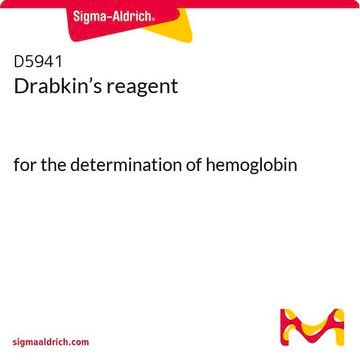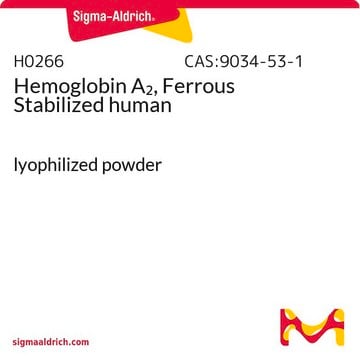H4890
Anti-Human Hemoglobin antibody produced in rabbit
whole antiserum
Sign Into View Organizational & Contract Pricing
All Photos(1)
About This Item
Recommended Products
biological source
rabbit
conjugate
unconjugated
antibody form
whole antiserum
antibody product type
primary antibodies
clone
polyclonal
contains
15 mM sodium azide
species reactivity
human
technique(s)
indirect ELISA: 1:8,000
UniProt accession no.
shipped in
dry ice
storage temp.
−20°C
target post-translational modification
unmodified
Gene Information
human ... HBB(3043)
Related Categories
General description
HBB (hemoglobin subunit β) codes for a β globin that consists of three exons. This gene is located on human chromosome 11p15. HBB is a serum protein that belongs to the histone-like protein family.
Immunogen
Hemoglobin isolated from normal adult human red blood cells and treated to remove lipoproteins.
Application
Anti-Human Hemoglobin antibody has been used in pulse chase experiments and western blotting.
Anti-Human Hemoglobin antibody produced in rabbit was used for immunoblotting using crude human cerebellar protein extracts and membrane extracts of human RBC. It was used for immunohistochemistry of human tongue cancer samples.
Applications in which this antibody has been used successfully, and the associated peer-reviewed papers, are given below.
Western Blotting (1 paper)
Western Blotting (1 paper)
Biochem/physiol Actions
HBB (hemoglobin subunit β) participates in oxygen transport from the lung to various peripheral tissues. Mutation in HBB result in Sickle cell disease (SCD). Overexpression of HBB has been observed in patients with periodontal disease.
Hemoglobin (Hb) is oxygen-binding metalloprotein that is present in the red blood cells. The most abundant Hb is HbA tetramer that is made up of two α, two β chains and the nonprotein heme group. The heme group contains iron ion and a porphyrin ring. Mutations in Hb gene result in hemoglobinopathies, the best known being sickle-cell disease and thalassemias.
Preparation Note
treated to remove lipoproteins
Disclaimer
Unless otherwise stated in our catalog or other company documentation accompanying the product(s), our products are intended for research use only and are not to be used for any other purpose, which includes but is not limited to, unauthorized commercial uses, in vitro diagnostic uses, ex vivo or in vivo therapeutic uses or any type of consumption or application to humans or animals.
Not finding the right product?
Try our Product Selector Tool.
Storage Class Code
10 - Combustible liquids
WGK
WGK 3
Flash Point(F)
Not applicable
Flash Point(C)
Not applicable
Certificates of Analysis (COA)
Search for Certificates of Analysis (COA) by entering the products Lot/Batch Number. Lot and Batch Numbers can be found on a product’s label following the words ‘Lot’ or ‘Batch’.
Already Own This Product?
Find documentation for the products that you have recently purchased in the Document Library.
Customers Also Viewed
Amritha Suresh et al.
Disease markers, 32(1), 51-64 (2012-02-03)
Worldwide, the incidence of oral tongue cancer is on the rise, adding to the existing burden due to prevailing low survival and high recurrence rates. This study uses high-throughput expression profiling to identify candidate markers of resistance/response in patients with
Abdullah Sultan et al.
The Journal of biological chemistry, 288(45), 32326-32342 (2013-10-01)
Fibril formation of β2-microglobulin and associated inflammation occur in patients on long term dialysis. We show that the plasma protein haptoglobin prevents the fatty acid-promoted de novo fibril formation of β2-microglobulin even at substoichiometric concentration. The fibrils are cytotoxic, and
Erythrocyte Efferocytosis by the Arterial Wall Promotes Oxidation in Early-Stage Atheroma in Humans.
Sandrine Delbosc et al.
Frontiers in cardiovascular medicine, 4, 43-43 (2017-08-22)
Since red blood cells (RBCs) are the predominant cellular blood component interacting with the arterial wall, we explored the role of RBCs efferocytosis by vascular smooth muscle cells (vSMCs) in the initiation of human atheroma. The comparison of human healthy
A phylogenetic analysis of Borrelia burgdorferi sensu lato based on sequence information from the hbb gene, coding for a histone-like protein
Valsangiacomo C, et al.
International Journal of Systematic and Evolutionary Microbiology, 47(1), 1-10 (1997)
Proteomic analysis of saliva identifies potential biomarkers for orthodontic tooth movement
Ellias M F, et al.
TheScientificWorldJournal, 2012(1) (2012)
Our team of scientists has experience in all areas of research including Life Science, Material Science, Chemical Synthesis, Chromatography, Analytical and many others.
Contact Technical Service








